List of emperors of the Yuan dynasty
Rulers of the Mongol Empire and China (1206–1368) From Wikipedia, the free encyclopedia
The Yuan dynasty was an imperial dynasty of China, proclaimed on 18 December 1271 by Kublai Khan, which succeeded the Song dynasty and preceded the Ming dynasty. It also functioned as a continuation of the Mongol Empire, which was founded by Genghis Khan in 1206, but which subsequently split into four autonomous states. The emperors of the Yuan dynasty thus comprise both Kublai's successors as rulers of China and his predecessors up to his grandfather Genghis, who was retrospectively presented as the founder of the dynasty.
| Emperor of the Yuan dynasty | |
|---|---|
| 大元皇帝 | |
Imperial | |
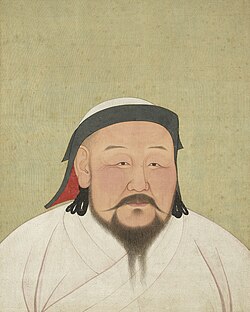 | |
| Details | |
| First monarch | Genghis Khan (Mongol Empire) Kublai Khan (Yuan dynasty) |
| Last monarch | Toghon Temür |
| Formation | 1206 (Mongol Empire) 1271 (Yuan dynasty) |
| Abolition | 1368 |
| Residence | Karakorum Khanbaliq |
| Appointer | Hereditary |
The rulers of the Yuan dynasty were nominally superior to those of the other three post-Mongol states, but each was de facto independent of the others and occupied with their own territories. The Yuan dynasty adopted Han political traditions, including the use of posthumous names, temple names and era names. Aside from the title of emperor, Yuan rulers also concurrently held the title of khagan.
Although the reigns of Kublai and his successor Temür were generally peaceful, weaknesses in the Yuan administration became apparent and led to a gradual breakdown of political stability. By the mid-14th century, the Yuan state became impossible to govern, and in 1368 the last emperor, Toghon Temür, was forced to flee China proper. His descendants continued to rule a rump state in Inner Mongolia, known as the Northern Yuan, until 1634.
Background
Summarize
Perspective
Through years of campaigning, Genghis Khan (c. 1162 – 1227) unified the tribes of the Mongolian steppe and was crowned khan of the Mongol Empire, or Yeke Monggol Ulus, in 1206. The campaigns of the following decades saw Mongol armies invade and conquer China, Central Asia, Persia and much of the Middle East, and Russia.[1] However, different branches of Genghis Khan's line became dominant in differing areas. As a result, by 1265, the once-united empire had begun to split into four independent states: the Golden Horde in modern-day Russia, the Chagatai Khanate in Central Asia, the Ilkhanate in the Near East, and a regime in China which was ruled by Genghis's grandson Kublai Khan and which was nominally superior to the rest.[2]
To appease his Han Chinese-majority population, Kublai declared the foundation of a new imperial dynasty titled Da Yuan. Essentially a way to convey the Yeke Monggol Ulus in Chinese conventions, the Yuan was officially proclaimed on 18 December 1271.[3] As the dynasty was regarded as a continuation of the Mongol Empire, contemporary writers retroactively described Genghis Khan as the dynastic founder;[a] the post-1271 emperors styled themselves as Mongol khans.[5] They continued the tradition, dating from the Qin dynasty (221–206 BC), of the ruling head of state being known as huangdi, or emperor.[6] In Chinese historical texts, emperors of the Yuan dynasty, along with the Tang and Song dynasties, are referred to by their temple names; they also had posthumous names and normally multiple era names.[7]
Kublai presided over the final conquest of the Song dynasty, which had preceded the Yuan. Although his reign was generally long and prosperous, weaknesses in the Yuan's economy, society, and administration became apparent after the death of his successor Temür in 1307, culminating in two decades of near-anarchy between 1320 and 1340.[8] Although the emperor Toghon Temür then managed to set up a stable government, an economic crisis led to a breakdown of the social order, and the powerful warlord Zhu Yuanzhang, having forced Toghon Temür to flee, established the Ming dynasty in 1368.[9] Members of the Yuan dynasty continued to rule a rump state in the Mongol heartland, commonly known as the Northern Yuan, until 1634.[10]
List of rulers
Summarize
Perspective
| Portrait | Khan name[11] | Personal name | Reign | Succession | Life details |
|---|---|---|---|---|---|
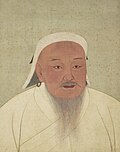 |
Genghis Khan 成吉思汗 Other names
|
Temüjin 鐵木真 |
1206 – 25 August 1227 (20–21 years) |
Son of Yesugei and Hö'elün | c. 1162 – 25 August 1227[b] (aged around 65) Unified the Mongol tribes, founded the Mongol Empire in 1206, initiated the Mongol conquests. Died in uncertain circumstances.[12] |
 |
None, known by his personal name
Other names
|
Tolui 拖雷 |
1227 – 1229 (1–2 years) (regency) |
Fourth son of Genghis | c. 1191 – September/October 1231 (aged around 40) Commanded armies in Central Asia and in China, and was a candidate to succeed his father as khan. Died in controversial circumstances.[13] |
 |
None, known by his personal name
Other names
|
Ögedei Khan 窝阔台 |
13 September 1229 – 11 December 1241 (12 years, 2 months and 28 days) |
Third son of Genghis | 1186 – 11 December 1241 (aged 55) Presided over the conquests of the Jin dynasty and Kievan Rus' and the invasion of Europe, refined the imperial administration, and built Karakorum as a capital city. Died from excessive drinking.[14] |
| None, known by her personal name
Other names
|
Töregene Khatun 脱列哥那 |
1242 – 1246 (3–4 years) (regency) |
Wife of Ögedei | Late 1180s – late 1246
Her five-year regency on behalf of her son Güyük was noted for its political intrigues and her excessive taxation demands, but after it ended she quickly lost influence and died.[15][c] | |
 |
None, known by his personal name
Other names
|
Güyük Khan 贵由 |
24 August 1246 – April 1248 (1 year, 7 months) |
Son of Ögedei and Töregene | 1206 – April 1248 (aged 41–42) Reversed his mother's economic policies and removed her associates from power; quarrelled with his cousin Batu and may have intended to campaign against him. Died of ill health.[17] |
| None, known by her personal name | Oghul Qaimish 斡兀立海迷失 |
1248 – 1251 (2–3 years) (regency) |
Wife of Güyük | Early 1200s – summer 1252 (aged around 50) An ineffective regent, she was outflanked by her political enemies who proclaimed Tolui's son Möngke as khan. After a coup attempt led by her sons failed, she was judged complicit and guilty of witchcraft, and executed.[18] | |
 |
None, known by his personal name
Other names
|
Möngke Khan 蒙哥 |
1 July 1251 – 11 August 1259 (8 years, 1 month and 10 days) |
First son of Tolui | 10 January 1209 – 11 August 1259 (aged 50) Purged those who had opposed his accession in the Toluid Revolution; sent his brother Hulegu to campaign in the Middle East, and himself led the invasion of the Song dynasty, during which he died of fever.[19] |
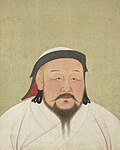 |
Setsen Khan 薛禪汗 better known as Kublai Khan Other names
|
Borjigin Kublai 孛兒只斤忽必烈 |
5 May 1260 – 18 February 1294 (22 years and 2 months) Era(s)
|
Second son of Tolui | 23 September 1215 – 18 February 1294 (aged 78) Established the Yuan dynasty in 1271, completed the conquest of the Song dynasty, won the Toluid Civil War, and moved the capital to Khanbaliq. Died of natural causes.[20] |
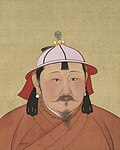 |
Öljeytü Khan 完澤篤汗 Other names
|
Borjigin Temür 孛兒只斤鐵穆耳 |
10 May 1294 – 10 February 1307 (12 years and 9 months) Era(s)
|
Grandson of Kublai | 15 October 1265 – 10 February 1307 (aged 41) His reign was prosperous yet conservative, implementing policies intended to ensure stability, but he failed to resolve increasing ineffiency in the Yuan administration. Died of natural causes.[21] |
 |
Külüg Khan 曲律汗 Other names
|
Borjigin Haishan 孛兒只斤海山 |
21 June 1307 – 27 January 1311 (3 years, 7 months and 6 days) Era(s)
|
Great-grandson of Kublai | 4 August 1281 – 27 January 1311 (aged 29) Disregarded established systems, rapidly expanded the bureaucracy, and caused immense fiscal difficulties. Died of natural causes.[22] |
 |
Buyantu Khan 普顏篤汗 Other names
|
Borjigin Ayurbarwada 孛兒只斤愛育黎拔力八達 |
7 April 1311 – 1 March 1320 (8 years, 10 months and 23 days) Era(s)
|
Brother of Külüg | 9 April 1285 – 1 March 1320 (aged 34) Reversed most of his brother's policies, reintroduced the Confucian examination system, and codifed laws, but failed to restore fiscal order and was undermined by factional struggles. Died of natural causes.[23] |
| Gegeen Khan 格堅汗 Other names
|
Borjigin Shidibala 孛兒只斤硕德八剌 |
19 April 1320 – 4 September 1323 (3 years, 4 months and 16 days) Era(s)
|
Son of Ayurbarwada | 22 February 1302 – 4 September 1323 (aged 21) Attempted to reduce the power of the minister Temuder and instituted monetary reforms after the latter's death, but was killed in a coup by Temuder's supporters.[24] | |
| None, known either by his personal or era name | Borjigin Yesün Temür 孛兒只斤也孫鐵木兒 |
4 October 1323 – 15 August 1328 (4 years, 10 months and 11 days) Era(s)
|
Great-Grandson of Kublai | 28 November 1293 – 15 August 1328[d] (aged 34) Acceded through assassination but achieved stability by purging those who had brought him to power; restored religious impartiality in the administration. Died of natural causes.[26] | |
| None, known either by his personal or era name | Borjigin Ragibagh 孛兒只斤阿剌吉八 |
October 1328 – 14 November 1328 (1 month) Era(s)
|
Son of Yesün | 1320 – 14 November 1328 (aged 8) Child emperor; probably murdered amid the War of the Two Capitals.[27] | |
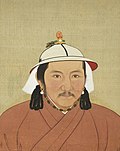 |
Jayaatu Khan 札牙篤汗 Other names
|
Borjigin Tugh Temür 孛兒只斤圖帖睦爾 |
16 October 1328 – 26 February 1329 (4 months and 10 days) Era(s)
|
Son of Külüg | 16 February 1304 – 2 September 1332 (aged 28) Abdicated in favor of his brother Khutughtu Khan.[28] |

|
Khutughtu Khan 忽都篤汗 Other names
|
Borjigin Kusala 孛兒只斤和世剌 |
27 February 1329 – 30 August 1329 (6 months and 3 days) Era(s)
|
Son of Külüg | 22 December 1300 – 30 August 1329 (aged 28) Briefly ruled before being killed by El Temür.[27] |
 |
Jayaatu Khan 札牙篤汗 (second reign) |
Borjigin Tugh Temür 孛兒只斤圖帖睦爾 |
8 September 1329 – 2 September 1332 (2 years, 11 months and 25 days) Era(s)
|
Son of Külüg | 16 February 1304 – 2 September 1332 (aged 28) A patron of the arts and scholarship, his reign was dominated by the ministers El Temür and Bayan of the Merkid. Died of natural causes.[28] |
 |
None, known by his personal name
Other names
|
Borjigin Rinchinbal 孛兒只斤懿璘質班 |
23 October 1332 – 14 December 1332 (1 month and 21 days) Era(s)
|
Son of Khutughtu | 1 May 1326 – 14 December 1332 (aged 6) Child emperor; died of sudden illness.[29] |
| Ukhaghatu Khan 烏哈噶圖汗 Other names
|
Borjigin Toghon Temür 孛兒只斤妥懽帖睦爾 |
19 July 1333 – 10 September 1368 (35 years, 2 months and 22 days) Era(s)
|
Son of Khutughtu | 25 May 1320 – 23 May 1370 (aged 49) Restored stable government, but an economic crisis led to a breakdown of the social order; was forced to flee to Karakorum in 1368 by the warlord Zhu Yuanzhang, and founded the Northern Yuan dynasty in Inner Mongolia. Died of natural causes.[31] | |
Timeline

See also
References
External links
Wikiwand - on
Seamless Wikipedia browsing. On steroids.
